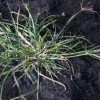 Goosegrass is an annual plant that produces a prostrate, mat-like rosette with flattened stems radiating from a central point. It is often described as looking like someone has stepped in the middle of the plant, flattening it out. Because of the whitish to translucent color of the leaf sheath margins, goosegrass usually appears white to silver; this is why it is known as white or silver crabgrass. Goosegrass is found year-round in southern Florida and is commonly associated with newly planted and stubble (ratoon) sugarcane fields. This 3-page fact sheet was written by Dennis Calvin Odero, Ron Rice, and Les Baucum, and published by the UF Department of Agronomy, January 2013.
Goosegrass is an annual plant that produces a prostrate, mat-like rosette with flattened stems radiating from a central point. It is often described as looking like someone has stepped in the middle of the plant, flattening it out. Because of the whitish to translucent color of the leaf sheath margins, goosegrass usually appears white to silver; this is why it is known as white or silver crabgrass. Goosegrass is found year-round in southern Florida and is commonly associated with newly planted and stubble (ratoon) sugarcane fields. This 3-page fact sheet was written by Dennis Calvin Odero, Ron Rice, and Les Baucum, and published by the UF Department of Agronomy, January 2013.
http://edis.ifas.ufl.edu/sc096
Category: Agriculture
Biology and Control of Coast Cockspur in Sugarcane (SSAGR366/SC095)
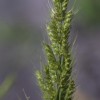 Coast cockspur is a relative of barnyardgrass that is native to North America. In South Florida, coast cockspur typically begins to infest sugarcane during the onset of rainfall in late spring. This 2-page fact sheet was written by Dennis Calvin Odero, Ron Rice, and Les Baucum, and published by the UF Department of Agronomy, January 2013.
Coast cockspur is a relative of barnyardgrass that is native to North America. In South Florida, coast cockspur typically begins to infest sugarcane during the onset of rainfall in late spring. This 2-page fact sheet was written by Dennis Calvin Odero, Ron Rice, and Les Baucum, and published by the UF Department of Agronomy, January 2013.
http://edis.ifas.ufl.edu/sc095
Spiral Nematode, Helicotylenchus pseudorobustus (Steiner, 1941) Golden, 1956 (Nematoda: Tylenchida: Hoplolaimidae) (EENY544/IN973)
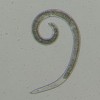 Spiral nematodes of the genus Helicotylenchus are among the most ubiquitous plant-parasitic nematodes worldwide. Helicotylenchus pseudorobustus is a species common in Florida and the southeastern United States and is frequently found associated with turfgrasses and other grass hosts in the region. On most plants, it is not considered particularly damaging, but recent research has shown that this species suppresses growth of certain turfgrass hosts. Seashore paspalum, a turfgrass used in tropical and subtropical regions, is particularly susceptible to infestation. This 4-page fact sheet was written by William T. Crow, and published by the UF Department of Entomology and Nematology, January 2013.
Spiral nematodes of the genus Helicotylenchus are among the most ubiquitous plant-parasitic nematodes worldwide. Helicotylenchus pseudorobustus is a species common in Florida and the southeastern United States and is frequently found associated with turfgrasses and other grass hosts in the region. On most plants, it is not considered particularly damaging, but recent research has shown that this species suppresses growth of certain turfgrass hosts. Seashore paspalum, a turfgrass used in tropical and subtropical regions, is particularly susceptible to infestation. This 4-page fact sheet was written by William T. Crow, and published by the UF Department of Entomology and Nematology, January 2013.
http://edis.ifas.ufl.edu/in973
Pesticide Safety Around Animals (ENY272/IG128)
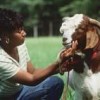 In general, infested animals are unhealthy and cannot be managed efficiently, so pesticides are commonly used to protect animals from pests. The successful control of pests requires careful mixing and application of recommended pesticides according to label directions. Besides ensuring the control of pests, applying pesticides at the recommended rate is necessary to prevent injury to the animal. This 5-page fact sheet was written by P. E. Kaufman and E. N. I. Weeks, and published by the UF Department of Entomology and Nematology, October 2012.
In general, infested animals are unhealthy and cannot be managed efficiently, so pesticides are commonly used to protect animals from pests. The successful control of pests requires careful mixing and application of recommended pesticides according to label directions. Besides ensuring the control of pests, applying pesticides at the recommended rate is necessary to prevent injury to the animal. This 5-page fact sheet was written by P. E. Kaufman and E. N. I. Weeks, and published by the UF Department of Entomology and Nematology, October 2012.
http://edis.ifas.ufl.edu/ig128
Classical Biological Control of Tropical Soda Apple with Gratiana boliviana (ENY865/IN971)
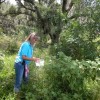 Tropical soda apple is a prickly shrub native to South America. First reported in Glades Co., Florida in 1988, it later spread to Georgia, Alabama, Louisiana, Texas, Mississippi, Tennessee, North Carolina, and South Carolina. It is a major problem in pastures and conservation areas. Negative impacts of tropical soda apple include reduction of cattle stocking rates, competition with native plants, and the costs associated with its control. Dense thickets of the weed also can disrupt the movement of wildlife. This 4-page fact sheet provides a summary of the major steps of the successful biological control program against tropical soda apple in Florida. The article covers the importance of the weed, identification and biology of the biological control agent, rearing and release efforts, establishment and impact, and efforts to communicate the outcomes of the program to stakeholders. Written by R. Diaz, J. Medal, K. Hibbard, A. Roda, A. Fox, S. Hight, P. Stansly, B. Sellers, J. Cuda and W. A. Overholt, and published by the UF Department of Entomology and Nematology, November 2012.
Tropical soda apple is a prickly shrub native to South America. First reported in Glades Co., Florida in 1988, it later spread to Georgia, Alabama, Louisiana, Texas, Mississippi, Tennessee, North Carolina, and South Carolina. It is a major problem in pastures and conservation areas. Negative impacts of tropical soda apple include reduction of cattle stocking rates, competition with native plants, and the costs associated with its control. Dense thickets of the weed also can disrupt the movement of wildlife. This 4-page fact sheet provides a summary of the major steps of the successful biological control program against tropical soda apple in Florida. The article covers the importance of the weed, identification and biology of the biological control agent, rearing and release efforts, establishment and impact, and efforts to communicate the outcomes of the program to stakeholders. Written by R. Diaz, J. Medal, K. Hibbard, A. Roda, A. Fox, S. Hight, P. Stansly, B. Sellers, J. Cuda and W. A. Overholt, and published by the UF Department of Entomology and Nematology, November 2012.
http://edis.ifas.ufl.edu/in971
Classical Biological Control of Air Potato in Florida (ENY864/IN957)
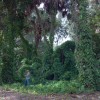 Air potato was introduced to Florida in 1905. By the 1980s, its vines were growing in thickets, waste areas, and hedges or fencerows in many parts of south and central Florida. By 1999, it was recognized as transforming plant communities by displacing native species, changing community structure and disrupting ecological functions. The air potato leaf beetle is a rather large, orange-red Asian leaf beetle. It feeds and develops only on air potato. The USDA-ARS Invasive Plant laboratory in Fort Lauderdale acquired this beetle from China and has begun an ambitious release program aimed at controlling air potato. This 3-page fact sheet was written by T. D. Center and W. A. Overholt, and published by the UF Department of Entomology and Nematology, October 2012.
Air potato was introduced to Florida in 1905. By the 1980s, its vines were growing in thickets, waste areas, and hedges or fencerows in many parts of south and central Florida. By 1999, it was recognized as transforming plant communities by displacing native species, changing community structure and disrupting ecological functions. The air potato leaf beetle is a rather large, orange-red Asian leaf beetle. It feeds and develops only on air potato. The USDA-ARS Invasive Plant laboratory in Fort Lauderdale acquired this beetle from China and has begun an ambitious release program aimed at controlling air potato. This 3-page fact sheet was written by T. D. Center and W. A. Overholt, and published by the UF Department of Entomology and Nematology, October 2012.
http://edis.ifas.ufl.edu/in957
Late Blight of Potato and Tomato (PP301)
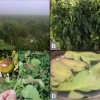 Both potato and tomato are susceptible to late blight, an aggressive disease capable of rapidly destroying entire fields. The disease is distributed worldwide and occurs wherever tomatoes or potatoes are grown and conditions favor disease development. This 4-page fact sheet was written by Ryan Donahoo and Pamela Roberts, and published by the UF Department of Plant Pathology, December 2012.
Both potato and tomato are susceptible to late blight, an aggressive disease capable of rapidly destroying entire fields. The disease is distributed worldwide and occurs wherever tomatoes or potatoes are grown and conditions favor disease development. This 4-page fact sheet was written by Ryan Donahoo and Pamela Roberts, and published by the UF Department of Plant Pathology, December 2012.
http://edis.ifas.ufl.edu/pp301
Management of Insect and Mite Resistance in Ornamental Crops (ENY843/IN715)
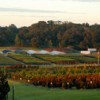 Resistance of arthropods to crop management chemicals has been problematic since the early era of synthetic organic pesticides. During the 1970s and early 1980s leafminer outbreaks heavily damaged herbaceous ornamental crops such as chrysanthemum, gypsophila, aster, and marigold in fields, shade houses and greenhouses. Several effective insecticides including organophosphates, carbamates, pyrethroids, and a triazine were identified for leafminer control during the outbreak; however, control was short-lived as the leafminer developed resistance to each insecticide.This 11-page fact sheet was written by James F. Price, Elzie McCord, Jr., and Curtis Nagle, and published by the UF Department of Entomology and Nematology, November 2012.
Resistance of arthropods to crop management chemicals has been problematic since the early era of synthetic organic pesticides. During the 1970s and early 1980s leafminer outbreaks heavily damaged herbaceous ornamental crops such as chrysanthemum, gypsophila, aster, and marigold in fields, shade houses and greenhouses. Several effective insecticides including organophosphates, carbamates, pyrethroids, and a triazine were identified for leafminer control during the outbreak; however, control was short-lived as the leafminer developed resistance to each insecticide.This 11-page fact sheet was written by James F. Price, Elzie McCord, Jr., and Curtis Nagle, and published by the UF Department of Entomology and Nematology, November 2012.
http://edis.ifas.ufl.edu/in715
Using Tensiometers for Vegetable Irrigation Scheduling in Miami-Dade County (ABE326/TR015)
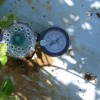 A tensiometer is a simple and relatively inexpensive tool that can be used to schedule irrigation in Miami-Dade County vegetable crops. Tensiometers continuously measure soil water potential or tension. If the tension in the soil is high, plants have to use more energy to extract soil water. If tension in the soil is low, then plants have lower energy requirements to extract soil water. This 6-page fact sheet was written by Kati W. Migliaccio, Teresa Olczyk, Yuncong Li, Rafael Muñoz-Carpena, and Tina Dispenza, and published by the UF Department of Agricultural and Biological Engineering, December 2012.
A tensiometer is a simple and relatively inexpensive tool that can be used to schedule irrigation in Miami-Dade County vegetable crops. Tensiometers continuously measure soil water potential or tension. If the tension in the soil is high, plants have to use more energy to extract soil water. If tension in the soil is low, then plants have lower energy requirements to extract soil water. This 6-page fact sheet was written by Kati W. Migliaccio, Teresa Olczyk, Yuncong Li, Rafael Muñoz-Carpena, and Tina Dispenza, and published by the UF Department of Agricultural and Biological Engineering, December 2012.
http://edis.ifas.ufl.edu/tr015
Swarm Control for Managed Beehives (ENY160/IN970)
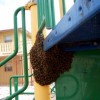 Honey bee swarms are a normal sign of a productive and strong honey bee colony. The population of honey bees in the environment grows and genes are exchanged as the new queen in the parent colony mates with drones from other colonies in the surrounding environment. Unfortunately, this activity often conflicts with the goals of the beekeeper, so good colony management includes swarm prevention. During the swarm season, hive owners should undertake proactive beekeeping practices to alter colonies in response to potential swarming behavior. In this way, the beekeeper maintains strong colonies with greater honey production and the potential to split and increase the total number of colonies, all of which makes beekeeping much more profitable for hive owners. This 6-page fact sheet was written by Sara DeBerry, John Crowley, and James D. Ellis, and published by the UF Department of Entomology and Nematology, November 2012.
Honey bee swarms are a normal sign of a productive and strong honey bee colony. The population of honey bees in the environment grows and genes are exchanged as the new queen in the parent colony mates with drones from other colonies in the surrounding environment. Unfortunately, this activity often conflicts with the goals of the beekeeper, so good colony management includes swarm prevention. During the swarm season, hive owners should undertake proactive beekeeping practices to alter colonies in response to potential swarming behavior. In this way, the beekeeper maintains strong colonies with greater honey production and the potential to split and increase the total number of colonies, all of which makes beekeeping much more profitable for hive owners. This 6-page fact sheet was written by Sara DeBerry, John Crowley, and James D. Ellis, and published by the UF Department of Entomology and Nematology, November 2012.
http://edis.ifas.ufl.edu/in970
Preserving Woodenware in Beekeeping Operations (ENY125/AA244)
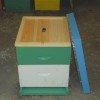 The predominant material used to construct honey bee colonies in the U.S. is wood. Though honey bee hive components are simple in design, they are subjected to many extreme management techniques that cause wear and tear, ultimately shortening the life of the equipment. This article discusses how to protect colony woodenware, particularly the pieces that are exposed to the elements. These include the bottom board, hive body/supers, and lids. This 4-page fact sheet was written by J. D. Ellis, W. H. Kern, and C. M. Zettel Nalen, and published by the UF Department of Entomology and Nematology, June 2012.
The predominant material used to construct honey bee colonies in the U.S. is wood. Though honey bee hive components are simple in design, they are subjected to many extreme management techniques that cause wear and tear, ultimately shortening the life of the equipment. This article discusses how to protect colony woodenware, particularly the pieces that are exposed to the elements. These include the bottom board, hive body/supers, and lids. This 4-page fact sheet was written by J. D. Ellis, W. H. Kern, and C. M. Zettel Nalen, and published by the UF Department of Entomology and Nematology, June 2012.
http://edis.ifas.ufl.edu/aa244
2013 Florida Blueberry Integrated Pest Management Guide (HS1156/HS380)
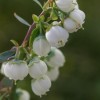 Recommendations are based on information from the manufacturer’s label and performance data from research and Extension field tests. This 31-page pest management guide was adapted for Florida by Jeffrey G. Williamson, Philip F. Harmon, Oscar E. Liburd, and Peter Dittmar, from the Southeast Regional Blueberry Integrated Management Guide, and published by the UF Department of Horticultural Sciences, November 2012.
Recommendations are based on information from the manufacturer’s label and performance data from research and Extension field tests. This 31-page pest management guide was adapted for Florida by Jeffrey G. Williamson, Philip F. Harmon, Oscar E. Liburd, and Peter Dittmar, from the Southeast Regional Blueberry Integrated Management Guide, and published by the UF Department of Horticultural Sciences, November 2012.
http://edis.ifas.ufl.edu/hs380
Guia de seguridad para el uso de pesticidas en el hogar (PI244)
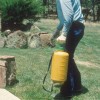 En este documento se describen las medidas que ayudarán en la toma de decisiones inteligentes y seguras sobre la utilización de plaguicidas en el hogar y césped/jardín. This 4-page fact sheet was written by Frederick M. Fishel, and published by the UF Department of Agronomy, December 2012.
En este documento se describen las medidas que ayudarán en la toma de decisiones inteligentes y seguras sobre la utilización de plaguicidas en el hogar y césped/jardín. This 4-page fact sheet was written by Frederick M. Fishel, and published by the UF Department of Agronomy, December 2012.
http://edis.ifas.ufl.edu/pi244
Equipo de Proteccion Personal para la Manipulacion de Pesticidas (PI243)
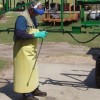 Este documento describe diversos artículos de equipo de protección personal (EPP) que se usan para proteger el cuerpo humano del contacto con pesticidas o residuos de pesticidas. El EPP incluye elementos tales como overoles o trajes protectores, calzado, guantes, delantales, mascarillas, gafas y sombreros. This 12-page fact sheet was written by Frederick Fishel, and published by the UF Department of Agronomy, December 2012.
Este documento describe diversos artículos de equipo de protección personal (EPP) que se usan para proteger el cuerpo humano del contacto con pesticidas o residuos de pesticidas. El EPP incluye elementos tales como overoles o trajes protectores, calzado, guantes, delantales, mascarillas, gafas y sombreros. This 12-page fact sheet was written by Frederick Fishel, and published by the UF Department of Agronomy, December 2012.
http://edis.ifas.ufl.edu/pi243
Identification and Control of Southern Sandbur (Cenchrus echinatus L.) in Hayfields (SSAGR364/AG373)
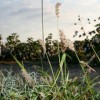 Southern sandbur is an annual grass that grows in pastures and cropland throughout the warm areas of the southern United States from Virginia to California. This native grass is adapted to dry, sandy soils and has a shallow, fibrous root system. It can easily invade a poorly managed field, diminishing the quality of a hay crop or grazing pasture. Southern sandbur seeds start to germinate in late spring, and germination continues through the summer and fall. Flowering occurs in late fall, and growth is consistent until the first frost. This 2-page fact sheet was written by Hunter Smith, Jason Ferrell, and Brent Sellers, and published by the UF Department of Agronomy, December 2012.
Southern sandbur is an annual grass that grows in pastures and cropland throughout the warm areas of the southern United States from Virginia to California. This native grass is adapted to dry, sandy soils and has a shallow, fibrous root system. It can easily invade a poorly managed field, diminishing the quality of a hay crop or grazing pasture. Southern sandbur seeds start to germinate in late spring, and germination continues through the summer and fall. Flowering occurs in late fall, and growth is consistent until the first frost. This 2-page fact sheet was written by Hunter Smith, Jason Ferrell, and Brent Sellers, and published by the UF Department of Agronomy, December 2012.
http://edis.ifas.ufl.edu/ag373
The Florida Bull Test 2011-2012 (AN284)
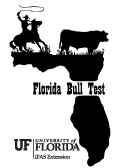 The North Florida Research and Education Center in Marianna, Florida annually hosts the Florida Bull Test. By controlling the environmental factors and taking Expected Progeny Differences (EPD’s) into account, the data clearly emphasizes the dual importance of genetics and environment in all cattle types. This 5-page fact sheet presents the procedures, rules, and results of the 2011-2012 test. Written by G. Cliff Lamb and Nicolas DiLorenzo, and published by the UF Department of Animal Sciences, December 2012.
The North Florida Research and Education Center in Marianna, Florida annually hosts the Florida Bull Test. By controlling the environmental factors and taking Expected Progeny Differences (EPD’s) into account, the data clearly emphasizes the dual importance of genetics and environment in all cattle types. This 5-page fact sheet presents the procedures, rules, and results of the 2011-2012 test. Written by G. Cliff Lamb and Nicolas DiLorenzo, and published by the UF Department of Animal Sciences, December 2012.
http://edis.ifas.ufl.edu/an284
Application of Ionophores in Cattle Diets (AN285)
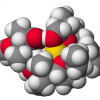 Beef cattle producers should consider using ionophores to increase calf gain and gain efficiency in a cost-effective manner. Ionophores are feed additives used in cattle diets to increase feed efficiency and body weight gain. They are compounds that alter rumen fermentation patterns. Ionophores can be fed to any class of cattle and can be used in any segment of the beef cattle industry. Similar to many other feed additives, ionophores are fed in very small amounts and supplied via another feedstuff as carrier for intake. Ionophores decrease incidence of coccidiosis, bloat, and acidosis in cattle. This 4-page fact sheet was written by Matt Hersom and Todd Thrift, and published by the UF Department of Animal Sciences, December 2012.
Beef cattle producers should consider using ionophores to increase calf gain and gain efficiency in a cost-effective manner. Ionophores are feed additives used in cattle diets to increase feed efficiency and body weight gain. They are compounds that alter rumen fermentation patterns. Ionophores can be fed to any class of cattle and can be used in any segment of the beef cattle industry. Similar to many other feed additives, ionophores are fed in very small amounts and supplied via another feedstuff as carrier for intake. Ionophores decrease incidence of coccidiosis, bloat, and acidosis in cattle. This 4-page fact sheet was written by Matt Hersom and Todd Thrift, and published by the UF Department of Animal Sciences, December 2012.
http://edis.ifas.ufl.edu/an285
Sturgeon Aquaculture: Specialized Techniques: Determining the Sex of Sturgeon by Direct Examination of the Gonad Using a Minimally Invasive Surgical Procedure (FA183)
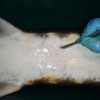 Because male sturgeon are harvested for meat at 2-4 years of age and females are retained for caviar production, being able to determine the sex of individual sturgeon has specific economical advantages. But it is difficult to tell females from males, especially when the fish are young (from hatch to 3 years old). This 5-page fact sheet describes the standard method and tools for determining the sex of sturgeon by direct examination of the gonad using a minimally invasive surgical procedure. Written by Frank A. Chapman and Joel P. Van Eenennaam, and published by the UF Department of Fisheries and Aquatic Sciences, November 2012.
Because male sturgeon are harvested for meat at 2-4 years of age and females are retained for caviar production, being able to determine the sex of individual sturgeon has specific economical advantages. But it is difficult to tell females from males, especially when the fish are young (from hatch to 3 years old). This 5-page fact sheet describes the standard method and tools for determining the sex of sturgeon by direct examination of the gonad using a minimally invasive surgical procedure. Written by Frank A. Chapman and Joel P. Van Eenennaam, and published by the UF Department of Fisheries and Aquatic Sciences, November 2012.
http://edis.ifas.ufl.edu/fa183
How Ethanol Is Made from Cellulosic Biomass (AE493)
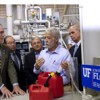 Ethanol can be derived from sugar-based, corn-based, and cellulose-based materials. Production of ethanol from sugar and corn is often viewed as competing with food production and increasing prices of food and fuel. But using non-edible cellulose-based biomass to produce ethanol minimizes competition with the food industry. This 4-page fact sheet provides a general overview of the production process for manufacturing ethanol from cellulosic biomass, including its constituents, conversion processes, and final products. Written by Zhaohui Tong, Pratap Pullammanappallil, and Arthur A. Teixeira, and published by the UF Department of Agricultural and Biological Engineering, November 2012.
Ethanol can be derived from sugar-based, corn-based, and cellulose-based materials. Production of ethanol from sugar and corn is often viewed as competing with food production and increasing prices of food and fuel. But using non-edible cellulose-based biomass to produce ethanol minimizes competition with the food industry. This 4-page fact sheet provides a general overview of the production process for manufacturing ethanol from cellulosic biomass, including its constituents, conversion processes, and final products. Written by Zhaohui Tong, Pratap Pullammanappallil, and Arthur A. Teixeira, and published by the UF Department of Agricultural and Biological Engineering, November 2012.
http://edis.ifas.ufl.edu/ae493
Mange in Companion Animals (ENY289/IN953)
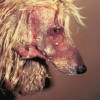 Mange is a persistent skin condition of mammals caused by infestation with parasitic mites. Mites are tiny arthropods, usually less than 1 mm in length and difficult to see with the naked eye. Adult mites have eight legs, and larvae have six. The effect of the mites on the animal’s skin, called “mange,” is the most visible sign of an infestation. This 6-page fact sheet describes several skin conditions commonly caused by parasitic mites in domestic animals. Written by E. N. I. Weeks and P. E. Kaufman, and published by the UF Department of Entomology and Nematology, September 2012.
Mange is a persistent skin condition of mammals caused by infestation with parasitic mites. Mites are tiny arthropods, usually less than 1 mm in length and difficult to see with the naked eye. Adult mites have eight legs, and larvae have six. The effect of the mites on the animal’s skin, called “mange,” is the most visible sign of an infestation. This 6-page fact sheet describes several skin conditions commonly caused by parasitic mites in domestic animals. Written by E. N. I. Weeks and P. E. Kaufman, and published by the UF Department of Entomology and Nematology, September 2012.
http://edis.ifas.ufl.edu/in953